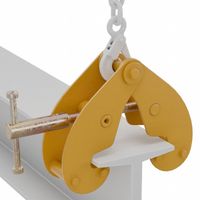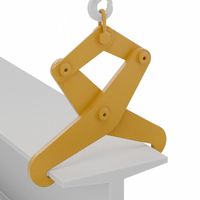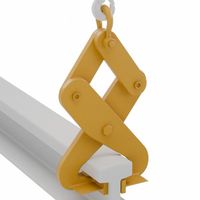Call +(254) 703 030 000 / 751 483 999 / 721 704 777
- Home
- Material Handling
- Lifting Pulling Positioning
- Below The Hook Lifting Devices
- Beam Rail Lifters
.....Read More
Frequently Asked Questions
What are beam and rail lifters used for?
Beam and rail lifters are specialized lifting devices used primarily in construction, manufacturing, and transportation industries to handle heavy and elongated materials such as steel beams, rails, and other structural components. These lifters are designed to ensure safe, efficient, and precise handling of these materials, which are often cumbersome and difficult to maneuver manually.
Beam lifters are typically used to lift and position steel beams during the construction of buildings, bridges, and other infrastructure projects. They can be attached to cranes or hoists and are equipped with mechanisms such as clamps, magnets, or vacuum systems to securely grip the beams. This allows for the safe lifting, moving, and placement of beams at various heights and angles, facilitating the assembly of structural frameworks.
Rail lifters, on the other hand, are specifically designed for handling railway tracks. They are used in the installation, maintenance, and repair of railways. Rail lifters can lift and position rails for alignment and fastening, ensuring the proper installation of tracks. This is crucial for maintaining the safety and efficiency of railway operations.
Both beam and rail lifters enhance workplace safety by reducing the need for manual handling, which can lead to injuries. They also improve productivity by allowing for quicker and more precise placement of materials. Additionally, these lifters can be customized to accommodate different sizes and weights of beams and rails, making them versatile tools in various industrial applications.
How do rail lifting tongs work?
Rail lifting tongs are specialized tools used for handling and moving rail tracks safely and efficiently. They consist of a pair of robust, curved arms that are designed to grip the rail securely. The tongs operate on a scissor-like mechanism, where the arms pivot around a central point. When the handles are pulled apart, the gripping ends close around the rail, and when the handles are pushed together, the grip is released.
The tongs are typically made from high-strength steel to withstand the heavy loads and stresses involved in lifting rails. The gripping ends are often serrated or textured to enhance the grip on the rail surface, preventing slippage during lifting.
To use rail lifting tongs, an operator positions the tongs over the rail, ensuring the gripping ends are aligned with the rail's profile. By applying force to the handles, the operator closes the tongs around the rail, securing it in place. The tongs can then be attached to a crane or hoist via a lifting eye or hook located at the top of the tongs. This setup allows for the rail to be lifted vertically and moved to the desired location.
The design of rail lifting tongs ensures that the weight of the rail itself helps to maintain the grip, as the downward force increases the clamping action. This self-tightening feature is crucial for safety, as it minimizes the risk of accidental release during transport.
Overall, rail lifting tongs provide a reliable and efficient means of handling rails, reducing manual labor and enhancing safety in rail construction and maintenance operations.
What is the difference between beam lifting tongs and beam lifting clamps?
Beam lifting tongs and beam lifting clamps are both tools used for lifting and handling beams, but they differ in design, application, and functionality.
Beam lifting tongs are typically designed with a scissor-like mechanism that grips the beam from the sides. They rely on the weight of the load to increase the gripping force, making them suitable for lifting beams vertically. The tongs automatically adjust to the width of the beam, providing a secure grip as long as the load is applied. They are often used for handling beams in construction and industrial settings where quick and repeated lifting is required.
Beam lifting clamps, on the other hand, are designed to attach to the flange of a beam. They usually have a screw mechanism or a cam lock that secures the clamp to the beam, providing a more fixed and stable grip. Clamps are versatile and can be used for both vertical and horizontal lifting, as well as for suspending beams. They are often used in situations where precise positioning and secure attachment are necessary, such as in assembly or installation tasks.
In summary, the main differences lie in their gripping mechanisms and applications: tongs use a scissor-like grip for vertical lifting, while clamps use a screw or cam lock for more versatile and secure attachment.
What safety precautions should be taken when using beam and rail lifters?
1. **Training and Certification**: Ensure operators are properly trained and certified to use beam and rail lifters. They should understand the equipment's operation, limitations, and safety features.
2. **Inspection and Maintenance**: Regularly inspect lifters for wear, damage, or defects. Perform routine maintenance as per the manufacturer's guidelines to ensure optimal functioning.
3. **Load Capacity**: Never exceed the lifter's rated load capacity. Ensure the load is evenly distributed and securely attached to prevent imbalance.
4. **Environment Assessment**: Evaluate the work environment for hazards such as overhead power lines, uneven surfaces, or restricted spaces. Ensure adequate lighting and clear communication signals.
5. **Personal Protective Equipment (PPE)**: Operators and nearby workers should wear appropriate PPE, including helmets, gloves, and safety boots, to protect against potential hazards.
6. **Secure Attachment**: Ensure the load is properly secured to the lifter using appropriate slings, hooks, or clamps. Double-check connections before lifting.
7. **Clear Communication**: Use standardized hand signals or communication devices to maintain clear communication between the operator and ground personnel.
8. **Safe Lifting Practices**: Lift loads slowly and steadily to avoid sudden movements. Keep the load as low to the ground as possible while moving.
9. **Emergency Procedures**: Establish and communicate emergency procedures in case of equipment failure or accidents. Ensure all personnel are aware of these protocols.
10. **Area Clearance**: Keep the area around the lifting operation clear of unnecessary personnel and obstacles to prevent accidents.
11. **Weather Conditions**: Avoid using lifters in adverse weather conditions such as high winds, rain, or lightning, which can affect stability and visibility.
12. **Documentation**: Maintain accurate records of inspections, maintenance, and operator training to ensure compliance with safety regulations and standards.
How do you choose the right beam or rail lifter for a specific application?
1. **Load Capacity**: Determine the maximum weight the lifter needs to handle. Choose a lifter with a capacity that exceeds this weight to ensure safety and efficiency.
2. **Beam/Rail Dimensions**: Consider the size, shape, and length of the beams or rails. Select a lifter that can accommodate these dimensions, ensuring a secure grip and balance.
3. **Material Type**: Identify the material of the beams or rails (e.g., steel, aluminum). Some lifters are designed for specific materials, affecting grip and handling.
4. **Lifting Environment**: Assess the working environment, including indoor or outdoor use, temperature, humidity, and potential exposure to corrosive elements. Choose a lifter with appropriate protective coatings or materials.
5. **Lifting Method**: Decide between manual, electric, pneumatic, or hydraulic lifters based on the power source availability and the level of automation required.
6. **Frequency of Use**: For frequent or continuous use, select a durable and robust lifter designed for high-duty cycles to minimize wear and maintenance.
7. **Safety Features**: Ensure the lifter has necessary safety features such as overload protection, secure locking mechanisms, and emergency stop functions.
8. **Ease of Operation**: Consider the ease of use, including controls, maneuverability, and setup time. User-friendly designs can improve efficiency and reduce operator fatigue.
9. **Compliance and Standards**: Verify that the lifter meets industry standards and regulations for safety and performance.
10. **Cost and Budget**: Balance the cost with the required features and performance. Consider long-term benefits and potential savings from reduced downtime and maintenance.
11. **Supplier Reputation**: Choose a reputable supplier with a track record of quality products and reliable customer support.
12. **Customization Needs**: If standard options do not meet requirements, consider custom solutions tailored to specific applications.
What are the weight limits for beam and rail lifters?
Beam and rail lifters, commonly used in construction and industrial settings, have weight limits that vary based on their design, material, and manufacturer specifications. Generally, these lifters are engineered to handle specific load capacities to ensure safety and efficiency.
1. **Beam Lifters**: These are typically used for lifting and moving steel beams or other heavy materials. The weight limits for beam lifters can range from a few hundred kilograms to several tons. Standard beam lifters might have capacities such as 1 ton, 2 tons, 5 tons, or even up to 10 tons or more, depending on the model and application. Custom-designed beam lifters can handle even greater weights, tailored to specific project needs.
2. **Rail Lifters**: Used primarily for lifting and positioning railway tracks, rail lifters also have varying weight capacities. These can range from 1 ton to 5 tons or more, depending on the type of rail and the lifting mechanism. Some rail lifters are designed to handle the weight of entire rail sections, which can be substantial, especially in heavy rail applications.
Both types of lifters must comply with industry standards and safety regulations, which dictate their design and testing to ensure they can safely handle their rated loads. It's crucial to consult the manufacturer's specifications and guidelines for each specific lifter to determine its exact weight limit and ensure it is suitable for the intended application. Additionally, regular maintenance and inspection are essential to maintain the integrity and safety of these lifting devices.
How do you maintain and inspect beam and rail lifters for safety?
To maintain and inspect beam and rail lifters for safety, follow these steps:
1. **Regular Inspections**: Conduct daily visual inspections before use. Check for any visible damage, wear, or deformation in the structure, hooks, and chains.
2. **Load Testing**: Perform load tests periodically as per manufacturer guidelines to ensure the lifter can handle its rated capacity without failure.
3. **Lubrication**: Regularly lubricate moving parts such as hinges, joints, and bearings to prevent rust and ensure smooth operation.
4. **Check Fasteners**: Ensure all bolts, nuts, and fasteners are tight and secure. Replace any that are worn or damaged.
5. **Examine Hooks and Chains**: Inspect hooks for cracks or excessive wear. Check chains for kinks, twists, or elongation. Replace any compromised components immediately.
6. **Inspect Safety Latches**: Ensure that safety latches on hooks are functioning properly to prevent accidental release of the load.
7. **Review Manufacturer’s Manual**: Follow the maintenance schedule and procedures outlined in the manufacturer’s manual for specific guidance.
8. **Training**: Ensure operators are trained in the proper use and inspection of the lifters. They should be aware of the signs of wear and potential failure.
9. **Record Keeping**: Maintain detailed records of all inspections, maintenance, and repairs. This helps in tracking the lifter’s condition over time.
10. **Environmental Considerations**: Store lifters in a dry, clean environment to prevent corrosion. Protect them from extreme temperatures and chemicals.
11. **Professional Inspection**: Have a certified professional conduct a thorough inspection annually or as required by regulations.
12. **Replace Worn Parts**: Promptly replace any worn or damaged parts with manufacturer-approved components to maintain safety standards.
By adhering to these practices, you ensure the safety and longevity of beam and rail lifters.


